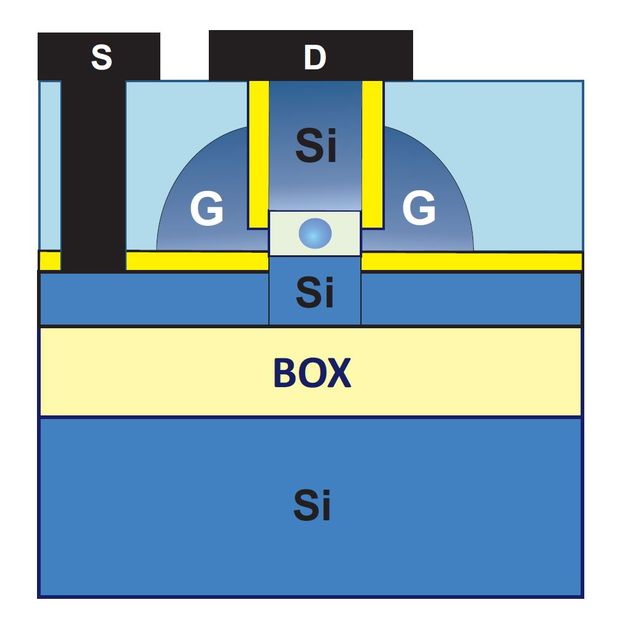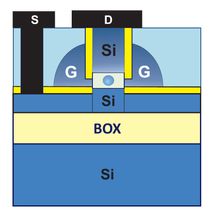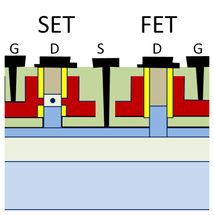Energy-saving minicomputers for the 'Internet of Things'
Advertisement
The 'Internet of Things' is growing rapidly. Mobile phones, washing machines and the milk bottle in the fridge: the idea is that minicomputers connected to these will be able to process information, receive and send data. This requires electrical power. Transistors that are capable of switching information with a single electron use far less power than field effect transistors that are commonly used in computers. However, these innovative electronic switches do not yet work at room temperature. Moreover, they are not compatible with the established production process in the field of microelectronics. Scientists working on the new EU research project 'Ions4Set' intend to change this. The program will be launched on February 1, involves partners from five European countries and is scheduled to run for four years. It is coordinated by the Helmholtz-Zentrum Dresden-Rossendorf (HZDR).

Schematic structure of a novel single-electron "gate-all-around" transistor: In a nanocolumn an insulating layer is surrounding the central quantum dot.
HZDR

Scheme of the novel device: The SET single quantum dot consists of just several hundred silicon atoms.
HZDR


"Billions of tiny computers will in future communicate with each other via the Internet or locally. Yet power consumption currently remains a great obstacle", says project coordinator Dr. Johannes von Borany from the HZDR. "Basically, there are two options: either one improves the batteries or one develops computer chips that require significantly less energy." For example, it has been known for years that single electron transistors are an energy-saving alternative to the commonly used field effect transistors (FET). As yet, however, they only work at low temperatures and, what is more, they are not compatible with the so-called CMOS technology that forms the technological basis for the integration of a huge number of FET components on a computer chip necessary to perform complex signal processing at laptops or smartphones.
The single electron transistor (SET) switches electricity by means of a single electron. The novel SET is based on a so-called quantum dot (consisting of just several hundred silicon atoms) embedded in an isolating layer that is sandwiched between two conducting layers. In order for a SET to function at room temperature, the silicon quantum dot needs to be smaller than five nanometers (1 nanometer = 1 millionth of a millimeter). Yet the electrons would not be able to pass through the transistor without another requirement being fulfilled: the distance between the quantum dot and the conducting layers must not be larger than two to three nanometers. As yet, these requirements could not be realized in nanoelectronics.
Self-organization of silicon nanodots in nanopillars
"Our transistor is based on a nanopillar. We have discovered a mechanism that ensures that the silicon quantum dot virtually form on their own", says Dr. Karl-Heinz Heinig, initiator of the new EU project. "We construct slim silicon pillars of about 20 nanometers into which we embed a six nanometer thin layer consisting of the isolator silicon dioxide. Silicon atoms are pushed into the isolator by irradiating the nanopillar with fast, charged particles. When the structures are subsequently subjected to strong heat, the atoms cluster at the center of the isolating layer to form a single silicon quantum dot." Leading European research institutions as well as the major players in the semiconductor industry, Globalfoundries, X-FAB and STMicroelectronics, have joined forces in the project to achieve the ability of reliably producing and reproducing billions of SET components made of nanopillars.
Demonstrator with two kinds of transistors: SET and FET complement each other
While CEA-Leti, a renowned French research institute for microelectronics, will produce the nanopillars with such a small size not yet achieved so far, the Spanish National Centre for Microelectronics in Barcelona (CSIC) is commissioned to build the demonstrator that will constitute the conclusion of the four-year EU project. However, the task the researchers have set themselves is actually far more complicated. The demonstrator cannot consist only of SET components that carry out the logical operations at room temperature. Classical FET components are an additional requirement, also in the form of nanopillars. Why? The energy-saving single electron transistors have too little power available to interact with the world outside their own chip. This is why the chip that should facilitate the triumphant advance of the 'Internet of Things' will contain FET in addition to SET nanopillars so that the former will be able to transmit the results of the SET operations to other chips and devices.




























































